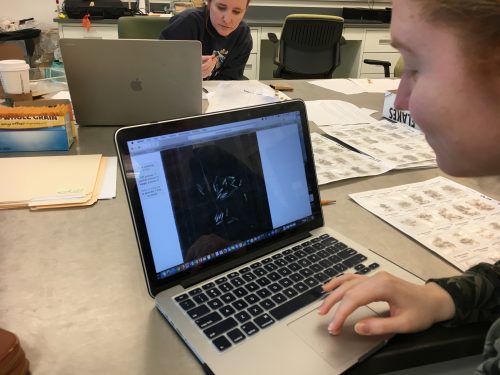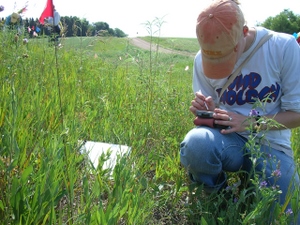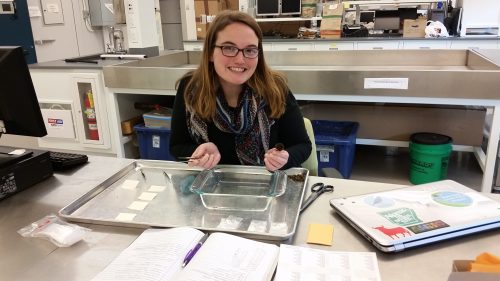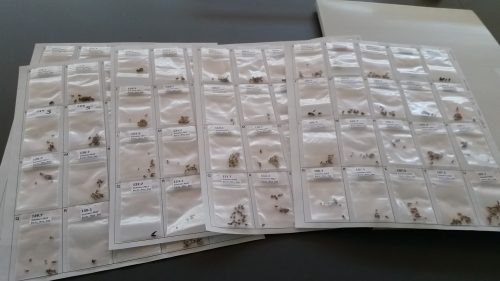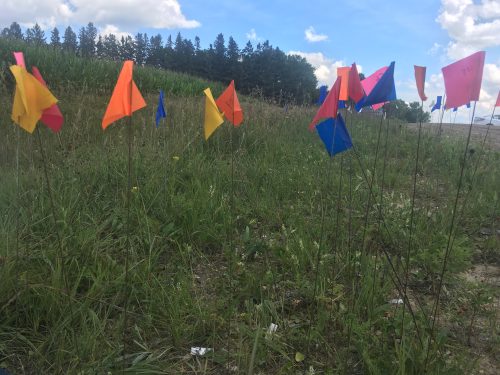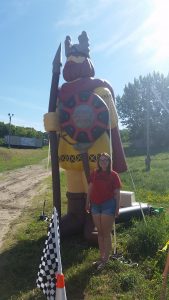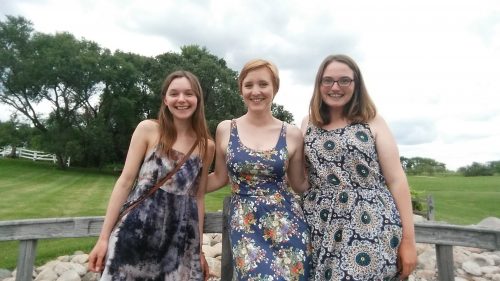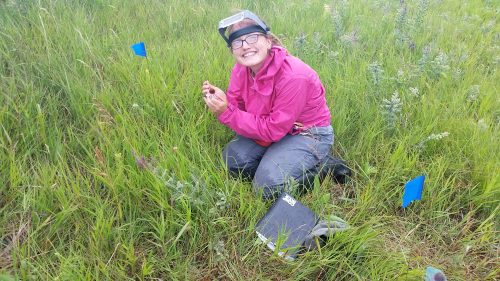|
|
For her REU project, Brigid gathered data to study the relationship between flowering density and seed set. She worked at Staffanson Prairie Preserve, which appears to have higher flowering density in burn years than non-burn years. This year, 2018, was a burn year on the east side of the preserve. Brigid and Team Echinacea kept track of the style persistence of about ~150 individuals many of which we have phenology and style persistence information from prior years. These individuals were harvested and their achene count and seed set will be assessed by volunteers and interns at the CBG.
Brigid also observed nearest neighbors for many of the plants that she tracked. It might be the cases that echinacea flowers are more successful if they have other flowering plants nearby. Synchrony is a large part of why fire is so important, and, since SPP is our largest remnant prairie, it’s the best place to test the relationship between fire and synchrony. Number of heads, phenology, and head size may also \ interact with fire — we’ll know once we look at the data!

Site: Staffanson Prairie Preserve
Start year: 1996
Overlaps with: Phenology in Remnants, Reproductive Fitness in Remnants
Data and Samples: We shot 90 GPS points for nearest neighbors, many of which were plants that flowered for the first time this year. We also harvested 22 heads that are awaiting cleaning at CBG
Products: None so far
This fall we had the wonderful opportunity to work with Cameo Chilcutt, a student of Northeastern Illinois University. Cameo spent the fall working in the lab and conducted her own growth chamber experiment with seeds from Selena’s summer REU project. Cameo was a great addition to the lab and asked some cool scientific questions about how water stress and maternal competitive environments affect germination in Lasthenia californica. Check out her final report posted below. We’ll miss having Cameo around but wish her luck in her future scientific endeavors!
Cameo Final Paper

Hi flog,
Things have really gotten going, here at Echinacea headquarters. Julie, Sarah, Lea, and I have been spending much of our time cleaning and counting Solidago, and we’ve made pretty good headway, each counting about 2-3 samples per hour. We’ve also made some preliminary observations about variability. We’ve found high variability between plants, but not within plants! For example, we’ve seen ranges of 3 to 372 heads per stalk, and anything from 7 to 24 achenes per head in different plants. But within a plant, achenes per head is relatively uniform, generally ranging by ~2 achenes, which should allow Lea to precisely estimate total number of achenes per plant.
In addition to the Solidago, we’ve been working on Liatris. We finished the most important part of estimating potential reproductive success: x-raying the achenes to see if they contain seeds. This process involves placing baggies filled with Liatris achenes over a reusable x-ray film, shooting x-rays through the achenes, and quickly feeding the film through a machine that digitizes the film and allows for online counting of full and empty achenes. From this, we can estimate proportion of achenes containing seeds, multiply this proportion by number of achenes, and thus estimate reproductive potential of the plant. Because my project doesn’t involve seed set, Julie will be doing all the counting for Liatris (Fig. 1) while Sarah will handle counting for Solidago x-rays.
Until next time,
Tris

Fig. 1. Julie diligently counts full and empty Liatris achenes while Lea continues to count Solidago heads.
It’s time to prepare annual reports to NSF for our two long-term awards through CBG & through UMN. The period covers 1 April 2017 through 31 March 2018. So, here’s a brief recap of activities from the past 12 months including the summer 2017 field season.
Last spring we were busy in the lab. Led by interns Amy & Scott, volunteer citizen scientists at the Chicago Botanic Garden started cleaning heads harvested in summer 2016 to count all of the achenes to generate a detailed and precise dataset of annual plant reproductive fitness. We were way behind because of the huge flowering year in 2015. We worked all fall & winter and we are in good shape now. Led by Tracie, we are cleaning 1148 heads harvested from plots in 2017, which we will finish over this summer.
Several undergraduate students have worked on projects in the lab, including Nicolette, Ashley, Marisol, Nina, Trevor, and now Danielle. They are all gaining experience, learning a lot, and contributing to science! Graduate students are hard at work too. Lea has analyzed all of her summer phenology data on Solidago & Liatris. Kristen is working on the bee collection from last summer with Mike. They are both making research plans for summer 2018.
Last December, we submitted a paper to Oikos titled “Pollinator-Mediated Mechanisms for Increased Reproductive Success in Early Flowering Plants.” We haven’t heard anything for 101 days & wonder if it has disappeared into a black hole.
Our team accomplished a lot in summer 2017! The 2017 summer team, shown below, included three undergraduate students (Ashley, Will & Wes), a high-school student (Anna), two graduate students (Lea & Kristen), and two recent college grads (Tracie & Alex)–not to mention the usual suspects, Gretel, Ruth & Stuart. We summarized progress on many summer projects last fall & made flog posts. Here are links to the updates organized into six groups.
First, we measured survival, growth, and flowering effort of our model plant, Echinacea angustifolia, in several experimental plots. The earliest was established in 1996 and the most recent in 2015:
Second, we measure other traits in these plots, including flowering phenology. We also have some treatments, such as pollen addition and aphid addition, which we apply every year. Will has super-cool estimates of the heritability of flowering timing. He is polishing the manuscript and will submit it soon. Amy W. has a manuscript in review that quantifies reproductive synchrony in the 1996 cohort of plants. She estimated how much within-year synchrony (daily phenology) and among-year synchrony (annual flowering) contribute to long-term mating opportunities.
Third, we make observations of Echinacea plants in natural prairie remnants in our study area, including flowering phenology, survival, reproduction, and incidence of disease. Scott is investigating effects of fire on population growth rates in our remnants using a life-table response experiment approach. While she is on sabbatical, Amy D. is analyzing the seedling establishment dataset.
Fourth, we study plant species other than Echinacea angustifolia and we are very interested in pollinators, including native solitary bees.
Fifth, two REU participants worked on our Team last summer. Here are updates of their projects.
Sixth, we are worried about non-native Echinacea plants that are used in restorations and how they impact populations of the native Echinacea angustifolia. We have several ongoing experiments that investigate a population of Echinacea pallida introduced within our study area.
 The Team from summer 2017
An ideal position for either an undergraduate or a graduate interested in gaining field experience.
The Echinacea Project is looking for interested and enthusiastic summer field assistants for the 2019 summer field season. Our project investigates how small population size and reduced genetic diversity influence individual fitness, population demographics, plant-insect interactions and evolution in the purple coneflower, Echinacea angustifolia. Summer field assistants will help maintain experimental plots, observe pollinators, remove invasive species, harvest seed, collect data for several long-term research projects, and establish new experiments. This is a great opportunity for aspiring ecologists, conservation biologists, and evolutionary biologists to gain research experience and learn about the ecology and evolution of plants in fragmented prairies! Read about what it’s like working and living in Minnesota.
Qualifications: We are looking for undergraduates or recent graduates who are willing to work outdoors in adverse conditions, exhibit patience, possess good hand-eye coordination and fine motor skills, work well independently and as part of a team, and have an interest in scientific research. Members of groups underrepresented in science are particularly encouraged to apply. No experience is necessary, but you must be enthusiastic and hard-working.
Details: The field season runs from June to October. We anticipate hiring assistants from June through August, with the possibility of extension later into the fall. There is a $550/week stipend and housing is supplied.
How to apply
- Please fill out the online form at this link.
- Send a cover letter, your resume, and a transcript (unofficial OK) in one email to echinaceaProject@gmail.com. Use the subject line: “Summer Field Assistant 2019” and format your cover letter, resume, and transcript as pdf files. Begin each file name with your surname. Please ask one of your references to send a letter of recommendation to echinaceaProject@gmail.com.
 Laura taking data In your cover letter please include…
- why you are interested
- what are your future plans
- when you can start and end
- who will serve as your reference
- your email and phone number
Send your application via email to echinaceaProject@gmail.com by 7 March 2019.
Students who are now and will be undergraduates in Fall 2019, should also consider an REU internship.
You are welcome to apply to multiple positions with the same application. Please indicate which positions you are interested in on the form you submit with your application.
Review of applications will begin on 7 March 2019. We’ll accept applications until positions are filled. Be sure to include an email address and phone number where you can be reached during March.
Members of groups underrepresented in science are particularly encouraged to apply.
More information
First, read about our field season! If you have any questions, contact a team member via e-mail. Read about our lab and field activities on the flog and more about the project’s background.
Hi Flog following!
I’m excited to have worked in the Echinacea Project’s lab at the Chicago Botanic Garden for the past few days. While I was here, I worked on the seed set portion of my summer 2017 REU project (which I have now named Barto’s Nice Experiment), and I caught up with many friends from the field season. It’s definitely been a fun week for me in the Chicago area!
At the end of the summer, the team collected my experimental Echinacea heads from the Nice Island remnant in Minnesota after I left. When I came to the garden with Tracie on Thursday of last week, I began dissecting them. I started by separating all rows from each other, but I quickly realized I was only able to accurately distinguish the odd rows (which had painted bracts). To work efficiently, I categorized all achenes into 4 groups based on where they came from in each head: Row 1, Row 3, Row 5, Row 7, or Even Row. Between Thursday, Friday, and the first half of today, I cleaned my 21 experimental heads. Each of the odd rows were put into their own baggie and attached to an x-raying sheet. With the guidance of Tracie, I was able to capture images that show the fullness of all of my odd-row achenes. With this data, I can create a GLM in R like I did with my pollination data from the summer and model which experimental variables (row within the capitulum, style age, and pulse/steady pollination treatment) affected the seed set in my experiment.
For now, I am going to count the full/partially full/empty achenes in my x-rays and get ready to return to Arkansas tomorrow.
 Ashley working in the Echinacea Project lab at the Chicago Botanic Garden.  Setting up the achenes for x-raying! Each of the baggies here has one row’s worth of achenes.  Final x-ray product for one row of achenes.
We had a big year for censusing plants in natural remnant populations. In 2017 we did both total demo, visiting all plants, and flowering demo, visiting just plants that flowered this year. Check out the chart below to see what we focused on at each site:
| Total Demo |
Aanenson, Around LF (partial), Common Garden, East of Town Hall, East Riley, Hegg Lake, Landfill West, Loeffler Corner East, NRRX, recruit he, recruit hp, recruit hs, Riley, RRX, South of Golf Course, Steven’s Approach, transplant plot |
| Flowering Demo |
Around LF, BTG, DOG, Elk Lake Road East, Golf Course, KJs, Krusemark, Landfill East, Liatris Hill, Loeffler Corner West, Near Town Hall, Nessman, NNWLF, North of Golf Course, NWLF, On 27, recruit el, recruit hw, recruit ke, recruit kw, RRXDC, Staffanson East Unit, Staffanson West Unit, Tower, Town Hall, West of Aanenson, Woody’s, Yellow Orchid Hill East, Yellow Orchid Hill West |
 We stake to locations where flowering plants have been found in the past and place a flag there. This is the East Riley roadside remnant, an area with a lot of Echinacea close together and a high chance of getting mowed. When we find a new flowering Echinacea plant, we give it a tag and get its location with a survey-grade GPS (better than 6 cm precision). Then, we can revisit this plant for years to come and monitor its survival and reproduction.
This season we added 5945 demo records and about 1375 survey records to our database. After over 20 years of this method, we now have a very rich longitudinal dataset of life histories including thousands of plants. REU Will Reed was a huge help organizing demo tasks for Team Echinacea over the summer and helping out with demap (the demographic census database) during the year.
Year started: 1996
Location: Roadsides, railroad rights of way, and nature preserves in and near Solem Township, Minnesota.
Overlaps with: Flowering phenology in remnants, fire and flowering at SPP
Data collected: demo records include Flowering status, number of rosettes, number of heads, neighbors within a 12 cm radius of plants found. These are all taken with PDAs that sync with an MS Access database. They are all transferred to the demap R repository in bitbucket with git version control.
GPS points shot: Points for each flowering plant this year shot mostly in SURV records, stored in surv.csv. Each location should be either associated with a loc from prior years or a point shot this year.
Products:
- Amy Dykstra’s dissertation included matrix projection modeling using demographic data
- Project “demap” merges phenological, spatial and demographic data for remnant plants
You can find out more about the demographic census in the remnants and links to previous posts regarding it on the background page for this experiment.
Over the next several weeks we are going to post updates on all the projects we worked on during summer 2017. Whew we did a lot–it might take a couple of months!
 Team Echinacea summer 2017 Put a bookmark on our update page to stay caught up. We’ll post all updates on that page.
Two new projects to look out for are Richardson’s “Liatris and Solidago phenology” and “Pollinators on roadsides.” Also, we’ll recap Barto’s & Braker’s REU projects. Stay tuned!
We didn’t work on the project Fire & flowering at Staffanson Prairie Preserve
or on Mating compatibility in remnants this summer. We didn’t do the first one because no burns were conducted at the preserve before this growing season. We contemplated assessing compatibility for another year, but there seemed to be more things that we wanted to do than there were people and time to do them.
My time here as a 2017 summer team member of the Echinacea Project is nearing its end. During my REU internship, I have had the opportunity to work under great mentors and with some great peers, and I’m sad I only have one week left. Nonetheless, I hope to make the most of my last week, and the data analysis part of that week continued today. This morning, I worked on my generalized linear model of my shrivel rate data in R using a model problem Stuart gave me. Lea helped me work through some errors returned to me while creating my models, and she used her Solidago figures to help explain the difference in additive and multiplicative interactions. Tomorrow, I hope to find what is significant in my study using the
 Viking set-up at Andes GLM!
While I worked on my analysis, there was a mountain bike race at Andes, and part of the set-up included a 3 meter viking near the finish line. Taking a picture with it was somethings I definitely could not pass up.
In the afternoon, Lea, Tracie, and I enjoyed a evening celebrating a great summer. Since it’s my last weekend before returning to my university in Arkansas, we wanted to have a great evening, so we enjoyed a night out in Alexandria!
 Tracie, Lea, and I in Alexandria We are excited to welcome our new roommate, Kristen, tomorrow!
Good afternoon, Flog readers!
As an REU intern and member of Team Echinacea, I get to do an independent research project of my choice. I’m excited to be studying the effect of style age, resource allocation, and pulse pollination on Echinacea angustifolia. I’ve attached my research proposal for your enjoyment and others’ future reference.
I’m excited to conduct this study!
My proposal: BARTO_Proposal_2017
 Bracts of rows 1, 3, and 5 painted.  Pollinating Echinacea
|
|



